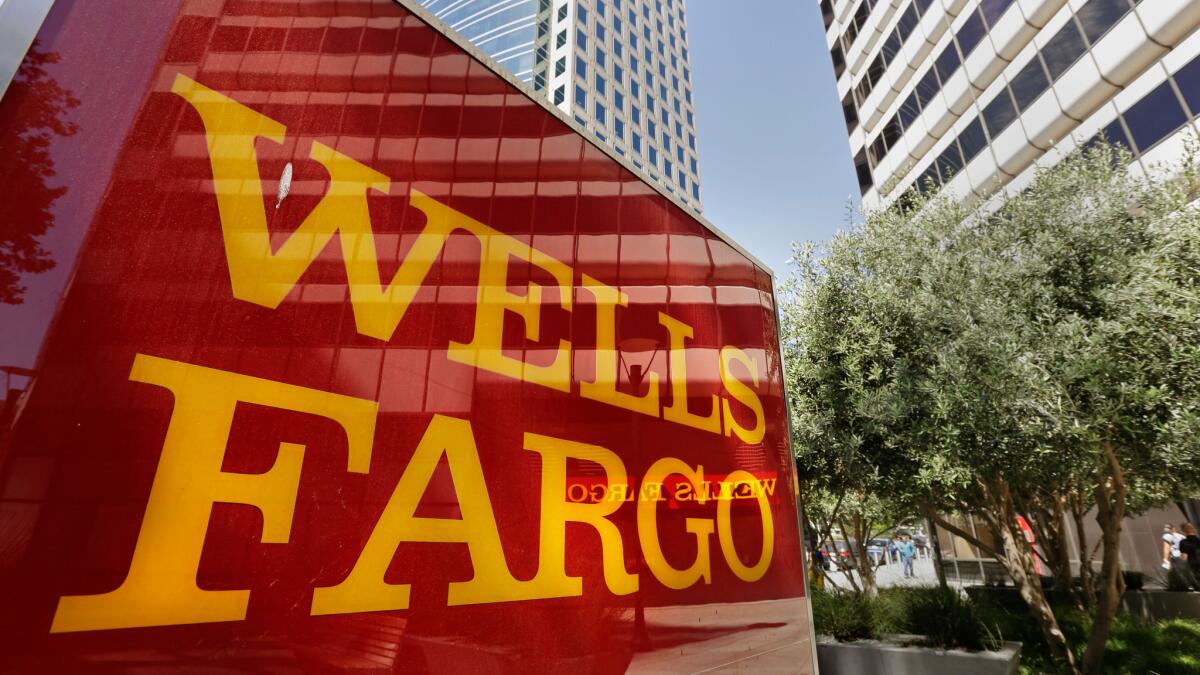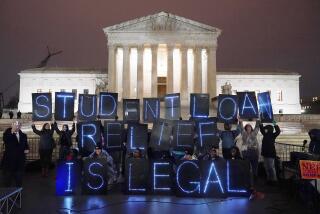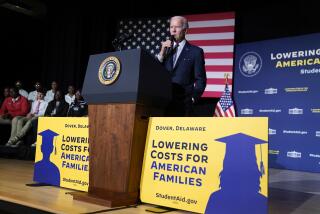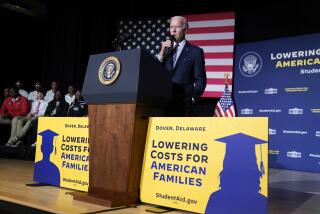Wells Fargo-Amazon deal offers a discount on private student loans

Wells Fargo & Co. is offering discounted interest rates on private student loans to Amazon.com customers, creating a partnership with the online retail giant at a time when private lenders are fighting for market share.
“We are focused on innovation and meeting our customers where they are — and increasingly that is in the digital space,” Wells Fargo’s head of education financial services, John Rasmussen, said in a statement. “This is a tremendous opportunity to bring together two great brands.”
Amazon Prime Student subscribers who apply for any of the bank’s education loan products are eligible to have their interest rate lowered by half a percentage point. Wells, which is based in San Francisco, will take off an additional quarter of a percentage point for borrowers who enroll in an automatic monthly loan repayment plan.
Interest rates on Wells undergraduate loans range from 5.94% to nearly 11% on a fixed-rate loan and 3.39% to 9.03% on a variable-rate loan. Students who enlist a co-signer can get lower rates.
Amazon.com Inc. charges $49 a year for its student subscription service, but company officials say members are not obligated to remain subscribers throughout their time in school or over the lifetime of the loan to receive the discount.
“Of course, Amazon is probably hoping that students will continue with Amazon Prime after they graduate, and Wells Fargo is probably hoping this will increase their loan volume,” said Mark Kantrowitz, publisher of Cappex, a college and scholarship search website. “It seems like a win-win.”
It’s not uncommon for banks to partner with retailers to offer discounts on shopping or travel to credit-card customers, but price reductions on loans are a bit unusual. Still, it’s not completely surprising, given the state of the private student loan market. Private lenders — banks, credit unions and other financial firms that provide education loans — hold only 7.5% of the $1.3-trillion student loan market, a fraction of their market share before the federal government decided in 2010 to lend directly to students.
Competition among private lenders is fierce, especially with the entrance of start-ups such as Social Finance and CommonBond that refinance private and federal loans. Lenders such as Sallie Mae and Citizens Bank are expanding their reach by promoting alternatives to the federal Parent Plus loan as well as offering flexible repayment periods, refinancing and loan modifications.
These efforts are producing results. The largest private lenders, including Wells and Sallie Mae, recorded $6.4 billion in loans at the end of March, up 7% from a year earlier, according to MeasureOne, a firm that tracks the market. Still, the government continues to dominate the marketplace.
Kantrowitz said the government’s student loan program remains the most affordable and flexible option for families needing to borrow for college.
Because the government caps the amount of money students can borrow each year, parents often take on debt to help out or co-sign private loans for their children. Needing to take that route, however, may be a sign of too much borrowing, Kantrowitz said. He cautions students to borrow no more than they expect to earn their first year out of college.
Interest rates on federal student loans are at an all-time low. Undergraduate students can expect to pay 3.76% in interest on new Stafford loans for the 2016-17 academic year; graduate students will be charged 5.31% interest. Government loans are only offered at fixed rates, and students don’t need co-signers with stellar credit to qualify for the lowest rate. What’s more, federal student loan borrowers can take advantage of the government’s income-driven repayment plans that cap monthly payments to a percentage of their earnings. There is nothing comparable in the private market.
“Amazon and Wells Fargo are trumpeting a discount while burying the sky-high rates on these private loans and without noting that they lack the consumer protections and flexible repayment options that come with federal student loans,” said Pauline Abernathy, vice president of the Institute for College Access & Success. “It is a cynical attempt to dupe current students who are eligible for federal student loans with a record-low 3.76% fixed interest rate into taking out costly private loans with variable interest rates currently as high as 13.74%.”
Abernathy points out that buried in the fine print of the Wells advertisement is a notice that the bank “reserves the right to modify or discontinue the discount program for future loans or to discontinue loan programs at any time without notice.”
Private student loans have drawn criticism for having inflexible repayment terms and weaker consumer protections than federal loans. But in recent years, more banks, credit unions and other financial firms that provide education loans have been offering competitive terms.
Still, Abernathy said, “Private loans are one of the riskiest ways to finance a college education. Like credit cards, they have the highest rates for those who can least afford them, but they are much more difficult to discharge in bankruptcy than credit cards and other consumer debts.”
Douglas-Gabriel writes for the Washington Post, which is owned by Amazon Chief Executive Jeffrey Bezos.
MORE FROM BUSINESS
Cannabis tech accelerator opens in Southern California
Airbnb taps former U.S. Atty. Gen. Eric Holder to curb discrimination
Tesla’s stock falls after Elon Musk reveals his ‘master plan’
More to Read
Inside the business of entertainment
The Wide Shot brings you news, analysis and insights on everything from streaming wars to production — and what it all means for the future.
You may occasionally receive promotional content from the Los Angeles Times.










